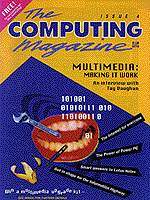| Timestream® Multimedia |
|
2432 Arrowhead Rd. • Port Republic • Maryland 20676 Tel 410-495-7624 |

The Multimedia RevolutionAn Interview with Tay Vaughan The Computing Magazine (Issue 4) McGraw-Hill Book Company Europe Shoppenhangers Road Maidenhead, Berkshire, SL6 2QL England Tel. ++44 (0) 628 23432 How would you define multimedia? Multimedia is any combination of text, graphic art, sound, animation, and video delivered by computer or other electronic means. When you weave together the sensual elements of multimedia - dazzling pictures and animations, engaging sounds, compelling video clips, and raw textual information - you can electrify the thought and action centres of most people's minds. When you also give them interactive control of the process, they can be enchanted. This is what the multimedia revolution is all about. What are the main problems faced when producing multimedia today? Weaving good multimedia tapestries can be complicated. Not only do you need to understand how to make each multimedia element stand up and dance, but you also need to know how to use computer tools and technologies, and the learning curves can be steep. Thankfully, hardware and software tools are more capable and friendly today than even a few years ago, and soon multimedia will be integrated into all computers and operating systems so that it becomes a natural part of what everybody does with computers - such as creating and editing animated and spoken e-mail messages, preparing interesting reports and presentations, and networking a video conference. When many people think of multimedia, it immediately conjures up certain images making it appear beyond their grasp. Are there ways that multimedia can be applied very simply and cost-effectively? As I have said, in another few years most personal computers sold will be multimedia-capable. Today's software for word processing, spreadsheets, database management, graphing, drawing, and presentation already works with sounds, images, video and animation. You can call a voice annotation, picture, or video from most word processing applications. You can click a cell in a spreadsheet to enhance its content with graphic images, sounds, and annotated bar charts. A database can include pictures, audio clips, and movies. Presentation software can easily generate interesting titles, visual effects, and animated illustrations. For someone just considering multimedia, could you offer three things they should bear in mind? Well, the good news is that costs are coming down and learning curves are becoming easier. The bad news, however. is that you still need to learn technical things about each of the multimedia elements if you want to do more than import into your projects ready-made clips created by others. And I would offer a warning: if you are a creative spirit, you may be seduced by the sheer power of your multi-media tools as you learn them. Be prepared to spend many hours in front of your computer. Imagine it's the year 2004. What lessons do think we might have learned about multimedia in the last ten years? I spoke earlier of a revolution in the way humans access and learn information. It's underway now. Significant learning will take place in the design and testing of the multimedia-based human interfaces that will be used to view the unimaginably varied types of data located on the international broad-band data highway currently under construction. How people will navigate through this massive 'library' (and how they will pay for it) is yet to be determined.
About the AuthorTay Vaughan is a recognized authority and pioneer in multimedia. He has designed and produced award-winning projects for clients such as Apple Computer, Lotus, Tandy, Sun and Novell. He is the president of Timestream Inc., a multimedia production company in Oakland, California.
About the BookMultimedia, Making It Work, Second Edition is a complete revision of Tay Vaughan's bestseller. It is a sweeping exploration, unequalled in scope and detail, of multimedia's diverse and technically intricate topics. Documenting the latest changes in multimedia development tools and techniques, and peppered with numerous case studies and first person accounts, this guide leads you through the maze of multimedia technology. You will find detailed information on all aspects of multimedia applications, from using elemental authoring tools to planning projects and delivering polished presentations.With the inclusion of Macromedia's Product Showcase on CD-ROM, readers get a very special bonus: demonstration versions of a selection of Macromedia products. ISBN: 0078 820359 Paperback/CD-ROM July 1994 For details of other multimedia books ask your local bookshop for your free copy of Computer Bookbase - a complete guide to McGraw-Hill computer books on a 3.5" disk.
|
| © 1994-2024 by Tay Vaughan |
